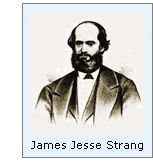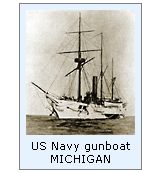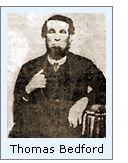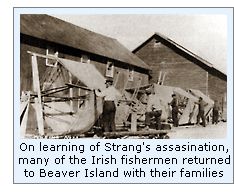The early days James Jesse Strang was born in New York State in 1813, where he became a
member of the Baptist church at the age of twelve, and began study of
the law at the age of twenty-one. Marrying his wife Mary, they moved
with their three children to Chautauqua County New York, where he worked
as a lawyer, Baptist Minister and the County Postmaster. James Jesse Strang was born in New York State in 1813, where he became a
member of the Baptist church at the age of twelve, and began study of
the law at the age of twenty-one. Marrying his wife Mary, they moved
with their three children to Chautauqua County New York, where he worked
as a lawyer, Baptist Minister and the County Postmaster.
With the loss of his Postmaster position in 1843, he moved his wife and three children to Wisconsin, and the following year again moved to Nauvoo Illinois. While in Nauvoo, Strang met and established a relationship with Joseph Smith, the founder of the fledgling Mormon Church, which was at the time headquartered in Nauvoo. Strang
converts to Mormonism Not long thereafter, Smith was jailed for destroying the office of a newspaper that had written criticizing articles about he and his Church. While in jail, Smith was assassinated, thereby leaving the Mormon Church without leadership. The struggle
for control
Strang and his group of dissident
followers went to Voree Wisconsin (later to become known as Spring
Prairie.) Strang took leadership of his new Church to heart, and quickly
tightened his grip over his followers, decrying material possessions,
forbidding the eating of meat, and tightly holding the sexual morality
of his followers to the highest standards. After publicly revealing this vision to his followers on September 13, 1845, four of his most trusted elders accompanied him to a location beneath an oak tree deep in the woods, at which point Strang informed them that it was the spot beneath which the secret was buried. The four men later reported that "the tree was surrounded by a sward of deeply rooted grass, such as is usually found in the openings, and upon the most critical examination we could not discover any indication that it had ever been cut through or disturbed."
Opening the clay case, it was found to contain six mysterious brass plates, which were taken as being of divine origin. This revelation sealed Strang's status as a "Prophet and a Seer of God" in the eyes of his followers, and their zealous dedication to their leader increased immeasurably. When the influx of gentile (non-Mormon) settlers into the Voree area threatened to disrupt their lifestyle, Strang set-out to identify a safe refuge for his flock. Arriving in Northern Michigan, Strang
began to search in the Charlevoix area, eventually identifying Beaver
Island with it's secluded harbor, lush forests and abundant fishing as
"where I will come to build up my kingdom." In deference to Brigham Young,
Strang had frequently spoken-out against the practice of polygamy. However, unbeknown to
most of the public, he secretly took Elvira
Field as his second wife in 1849. Field had been traveling with him
disguised as a man, and had been passing herself off under the name of Charles Douglas. Strang erected a large log temple, owned a commercial boat and saw mill, which was used to saw lumber for housing for the island's growing Mormon population. Strang then founded a newspaper "The Northern Islander," and published books and pamphlets defending his right of Divine rule.
Strang's control of his disciples began to widen beyond matters spiritual. Many consider his edict that women begin wearing bloomers, as opposed to the customary long skirts of the time, to have been a major component in the resentment that led to his eventual downfall. By 1851 Strang and his entourage managed to hold all the political offices on nearby Mackinac Island, to which Beaver Island and its neighboring islands were attached for judicial and elective purposes. However, the continuing unrest between the gentiles and Mormons on the island, combined with Strang's unconventional religious practices was not going unnoticed. The arrest The US Naval gunboat MICHIGAN was immediately dispatched to Beaver Island. Onboard, a US Marshall, Deputies and the District Attorney with highest level orders to deliver Strang and his followers to stand trial the Federal Court in Detroit. Though some subterfuge, almost one hundred of Strang's followers were lured to the ship, arriving in Detroit in May of 1851. Trial and
triumph It would appear that he did an admirable job, as against all expectation he won the case, and in victory he led his followers back to his Beaver Island Kingdom. The astounding court victory further sealed his power-base, and Strang was elected to the State legislature. Murder or
Martyrdom? As a result of his treatment, a strong resentment grew within Bedford for Strang and his teachings. It would appear that Bedford was not the only member of the community to have misgivings concerning Strang's leadership, as Bedford and a group of 40 other men ambushed Strang on June 16, 1856, mortally wounding the King. The wounded Strang, along with most of his followers, set sail for Voree two days later, where Strang passed away a month later on July 8 - King's Day. Epilogue
There have been persistent rumors that Strang's followers sequestered a stash of gold in Fox Lake as they were making their hasty escape from the island. Throughout the years, many treasure seekers have attempted to find the "Strang's treasure." None have succeeded. While it is likely that no treasure exists, It could also be that it just has not been found! To this day, a small and widespread
group of believers follow Strang's teachings, believing that Strang was
the true chosen successor to Smith. Click here to visit their
website, and learn more of Strang's teachings. |
 Strang even produced a document that he
claimed was written by Smith some time before his death, stating that
Strang was to be Smith's successor. While the document may have swayed a
few fence-sitters into the "Strangite" camp, it was not
sufficient to the beliefs of the majority. Thus, Young won the struggle
and assumed leadership of the Church. Young immediately excommunicated
Strang, and soon thereafter led his followers to Utah.
Strang even produced a document that he
claimed was written by Smith some time before his death, stating that
Strang was to be Smith's successor. While the document may have swayed a
few fence-sitters into the "Strangite" camp, it was not
sufficient to the beliefs of the majority. Thus, Young won the struggle
and assumed leadership of the Church. Young immediately excommunicated
Strang, and soon thereafter led his followers to Utah. Proceeding to dig, eventually
discovering an earthenware case, the witnesses further reported
"We examined as we dug all the way with the utmost care. We say,
with utmost confidence that no part of the earth through which we dug
exhibited any sign or indication that it had been moved or disturbed at
any time previous. The roots of the tree stuck down on every side very
closely, extending below the case, and closely interwoven with roots
from other trees. None of them had been broken or cut away. No clay is
found in the country like that of which the case is made."
Proceeding to dig, eventually
discovering an earthenware case, the witnesses further reported
"We examined as we dug all the way with the utmost care. We say,
with utmost confidence that no part of the earth through which we dug
exhibited any sign or indication that it had been moved or disturbed at
any time previous. The roots of the tree stuck down on every side very
closely, extending below the case, and closely interwoven with roots
from other trees. None of them had been broken or cut away. No clay is
found in the country like that of which the case is made." Friction continued to increase between
gentile and Mormon, fueled by Strang's suffocation of the whiskey
trade in the area, and his sudden open embracing of polygamy as a
"Divine requirement" of his followers. Many scuffles broke-out
between the two factions, leading to the "War of Whiskey
Point," won by Strang's followers when they fired a cannon into an
unruly gang of rebels assembled at the trading post. As a result of such
altercations, by the early 1850's most of the gentile population on
Beaver Island abandoned their homes for new lives on the mainland.
Friction continued to increase between
gentile and Mormon, fueled by Strang's suffocation of the whiskey
trade in the area, and his sudden open embracing of polygamy as a
"Divine requirement" of his followers. Many scuffles broke-out
between the two factions, leading to the "War of Whiskey
Point," won by Strang's followers when they fired a cannon into an
unruly gang of rebels assembled at the trading post. As a result of such
altercations, by the early 1850's most of the gentile population on
Beaver Island abandoned their homes for new lives on the mainland. The Michigan "Mormon trouble"
eventually reached President Millard Fillmore himself. Fillmore
instructed the Attorney General to issue orders to the U.S. district
attorney of Michigan to begin prosecution of Strang for offenses
punishable in the federal court. Some of the Federal charges being
delaying the mail, cutting timber from pubic lands, tax irregularities
and counterfeiting.
The Michigan "Mormon trouble"
eventually reached President Millard Fillmore himself. Fillmore
instructed the Attorney General to issue orders to the U.S. district
attorney of Michigan to begin prosecution of Strang for offenses
punishable in the federal court. Some of the Federal charges being
delaying the mail, cutting timber from pubic lands, tax irregularities
and counterfeiting. A group of Mormon men seized Bedford and
administered immediate justice through the administration of
seventy-nine lashes across Bedford's back.
A group of Mormon men seized Bedford and
administered immediate justice through the administration of
seventy-nine lashes across Bedford's back.  Beaver Island is still largely
populated by the descendents of those original Irish fishermen.
Beaver Island is still largely
populated by the descendents of those original Irish fishermen.